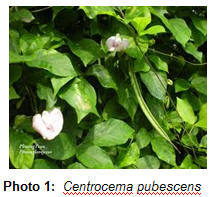 |
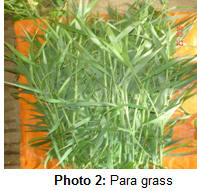 |
| Back to contents |
Effect of mixed or separate feedings and ration of Centrocema pubescens and Para grass on feed utilization, nutrient digestibility and growth performance of crossbred rabbits
Nguyen Thi Kim Dong and Nguyen Van Thu
Cantho University, Vietnam
ntkdong@ctu.edu.vn
A study was conducted at the experimental farm and laboratory of Can tho University to evaluate feed utilization, nutrient digestibility and growth performance of Crossbred rabbits. The experiment was a factorial design in which the first factor was feeding method (Separate and mix) and second factor was the levels of Centrocema pubescens : Para grass (20:80, 40:60, 60:40 and 80:20), with three replications and 4 rabbits per experimental unit. The results indicate that values of DM, CP, EE, NDF, ADF, ME intakes were significantly higher (P<0.05) in the separate feeding. The CP and EE intakes gradually increased (P<0.05) when increasing the levels of Centrocema pubescens in the diets. The apparent digestibility coefficients of NDF and CP, nitrogen intake and retention were significantly higher (P<0.05) for the rabbits offered separated feeds and the level of 80:20 Centrocema pubescens and Para grass. The parameters of N-NH3 and volatile fatty acid of caecal fluid were significantly higher (P<0.05) in separate feeding and with increasing levels of Centrocema pubescens in the diets. The daily weight gain, weight of carcass, and thigh meat of rabbits fed separated feeds and the level of 80:20 Centrocema pubescens and Para grass had the highest results (P<0.05).
It was concluded the separate feeding and the level of 80: 20 Centrocema pubescens and Para grass had better growth performance and gave higher economic efficiency.
Key words: Carcass straits, daily weight gain, nutrient intake, nitrogen retention
Introduction
Organic rabbit farming based on forages is a sustainable feeding system for the poor farmers to improve their economical lives in villages of Vietnam. Within these feeding strategies, forages and agricultural by-products are used as the main protein and fibre sources, while for the improved performance of growing rabbits, sources of soluble carbohydrate supplementation are very important (Leng, 2008 and Preston, 2008).
Besides, rabbits have characteristic of high feed selection based on types of feeding or size of feed particles as well as the type of feeds in order to meet nutrient requirement in their diets. Therefore feeding choice will increase feed intake of the forages-fed rabbits resulting in high performance. In the Mekong Delta has abundance of locally available forages almost all year round in which Para grass has high fibre content, while Centrocema pubescens with high crude protein. Thus the appropriated associations between these feeds will give balanced nutrient diets for rabbits. However, the understanding of this scientific area for rabbit performance has still limited in literatures. Therefore a study of nutrient utilization, digestion process and performance of growing rabbits based on forages mixed or separated and supplemented small amount of protein and energy from soya waste and dried sweet potato should be investigated for improving rabbit production and increasing farmers’ income.
Materials and methods
The experiment was conducted in the experimental farm in Cantho City. Ninety six Crossbred rabbits (local x improved breeds) at 6 to 8 weeks of age were devised to 3 blocks corresponding with 3 ranges of live weight from 440, 520 and 650 g/rabbit. They were allotted in a factorial design with 2 factors and four rabbits (balanced sex) in an experimental unit. The first factor was feeding method (Separate and mix) and second factor was level of Centrocema pubescens (CPU) and Para grass (PG) (20:80, 40:60, 60:40 and 80:20). Three replicates were applied for all treatments in the study. The Centrocema pubescens (CPU) and Para grass (PG) were hung and fed separately for first factor, while CPU and PG were chopped, then mixed and fed in a trough in the treatments for the second factor. Soya waste, extracted soybean and dried sweet potato waste were supplied at the same level of each feed for all treatments to provide protein and energy. The experimental period was lasted 10 weeks.
 |
 |
The animals were fed three times a day at 8:00 h, 14:00 h and 18:00 h. Centrocema pubescens (CPU) and Para grass (PG) were separately offered in the first factor, while they were chopped and mixed before feeding in the second factor. Fresh water was available for all rabbits almost all day and night time. The refusals and spillage were daily collected and weighed in the morning to calculate the feed intake. The animals were vaccinated to prevent hemorrhagic and parasite diseases.
The feeds and refusals were taken for analysis of DM, OM, CP, EE, NDF, ADF and ash following procedures of AOAC (1990) and Van Soest et al (1991). During the experiment four rabbits per experimental unit were individually weighed every week. Daily feed intakes, growth rate, and feed conversion ratios were measured and calculated. At the end of experiment the rabbits were slaughtered for evaluating carcass quality. The economic analysis was also done among the treatments.
The second experimental design was similar to that of the feeding trial; however, the two rabbits at 12 weeks of age were used. The animals had two weeks for adaptation and another week for getting samples. Feeds and refusals were daily measured. Urine was also collected for nitrogen analysis to calculate nitrogen retention. DM, CP, EE, NDF and ADF digestibility were employed according to Mc Donald et al (2002). At the end of the third week of this experiment the two rabbits of each experimental unit were slaughtered at 9.00 h (after feeding 3 hours) to get the caecal content that was treated immediately for measuring volatile fatty acid concentration by distillation (Barnett and Reid, 1957).
The data from both experiments were analyzed by analysis of variance using the ANOVA option of the General Linear Model of Minitab Reference Manual Release 13.21 (Minitab 2000). Economic analyses were done using current prices in Vietnamese Dong (VND) to compare differences of income and the feed cost in different treatments.
Results and discussion
The chemical compositions of the feed ingredients of rabbits are presented in Table 1.
|
Table 1: Chemical composition of feed ingredients (% in DM, except for DM which is on fresh basis) |
|||||||
|
Ingredients |
DM |
OM |
CP |
EE |
NDF |
ADF |
ME (MJ/kg DM) |
|
Centrocema pubescens |
25.4 |
91.9 |
22.0 |
6.20 |
45.0 |
32.0 |
7.70 |
| Para grass |
15.2 |
88.3 |
9.20 |
4.5 |
65.2 |
35.2 |
8.30 |
| Soya waste |
9.50 |
96.3 |
19.1 |
10.0 |
47.6 |
33.4 |
11.3 |
| Extracted soybean |
90.4 |
90.6 |
43.4 |
2.4 |
28.7 |
19.2 |
11.4 |
| Dried sweet potato waste |
94.3 |
97.1 |
2.70 |
1.59 |
15.6 |
5.85 |
13.4 |
| DM: dry matter, OM: organic matter, CP: crude protein, EE: ether extract, NDF: neutral detergent fiber, ADF: acid detergent fiber, ME: metabolizable energy (Maertens et al., 2002) | |||||||
Centrocema pubescens (CPU) had twice as much protein and much less than the NDF component compared to the Para grass (PG). The CP content of CPU used in our experiment is consistent with the value (21.2% CP) stated by Nguyen Le Thu Hang (2012), but being higher than the value (17.4 %CP) reported by Van Phu Vinh (2010). The NDF contents of CPU and PG in the current experiment were lower than those reported by Nguyen Thanh Tung (2012). This might have been caused by different collection seasons and soil characteristics.
Daily intakes of Centrocema pubescens, Para grass and nutrients of crossbred rabbits are shown in Table 2.
|
|
||||||||
|
Table 2: Daily intakes (g/rabbit) of feeds and nutrients of growing rabbits in feeding trial |
||||||||
|
Item |
Feeding method (FM) |
Centrocema pubecens level (CL) |
SE/P |
|
||||
|
Separate |
Mixed |
CPU20 |
CPU40 |
CPU60 |
CPU80 |
FM |
CL |
|
|
PG80 |
PG60 |
PG40 |
PG20 |
|||||
|
CPU-DM |
36.2 |
24.8 |
12.5a |
23.7b |
38.5c |
47.3d |
0.56/0.001 |
0.80/0.001 |
|
PG-DM |
32.6 |
27.3 |
47.0a |
37.2b |
23.6c |
12.0d |
0.42/0.001 |
0.59/0.001 |
|
DM |
61.8 |
56.8 |
58.2 |
58.9 |
61.3 |
58.9 |
0.95/0.002 |
1.34/0.42 |
|
OM |
57.3 |
52.7 |
53.9 |
54.4 |
56.8 |
54.2 |
0.82/0.002 |
1.17/0.33 |
|
CP |
10.8 |
9.65 |
9.05a |
9.70a |
10.9b |
11.2b |
0.12/0.001 |
0.17/0.001 |
|
EE |
2.87 |
2.55 |
2.53a |
2.63ab |
2.87c |
2.82bc |
0.05/0.001 |
0.06/0.008 |
|
NDF |
27.5 |
24 |
26.2 |
25.9 |
26.3 |
24.5 |
0.43/0.001 |
0.61/0.18 |
|
ADF |
16.2 |
14.1 |
15.0 |
15.1 |
15.7 |
14.9 |
0.25/0.001 |
0.36/0.41 |
|
ME(MJ/rabbit) |
0.62 |
0.59 |
0.60 |
0.60 |
0.62 |
0.60 |
0.008/0.019 |
0.01/0.58 |
|
CPU: Centrocema pubescens, PG: para grass. Means with different letters within the same rows are significantly different at the 5% level. CPU20-PG80, CPU40-PG60, CPU60-PG40, CPU80-PG20 were diets had Centrocema pubescens and para grass at levels of 20:80, 40:60, 60:40, 80:20%, respectively |
||||||||
Table 2 indicated that daily intake of CPU was significantly higher in separate feeding than in the mixed feeding (P<0.05), and the results increased with increasing levels of CPU in the diets, reaching the highest value (47.3 g) in the CPU80-PG20 diet (P<0.05). The significantly higher daily intake of PG was found in separate feeding, however the results decreased when increasing levels of CPU in the diets, the lowest value in the CPU80-PG20 diet (P<0.05). The total daily intakes of DM, OM, CP, EE, NDF, ADF and ME were higher for the separate feeding (P<0.05). The explanation was that the rabbits have high feed selection characteristics thus feeds offered separately stimulated them consume more feeds. However, the DM, OM, NDF, ADF and ME intakes were unaffected by the inclusion of graded CPU levels in the ratios of CPU and PG. The CP and EE intakes were significantly increased corresponding with increasing levels of CPU in the ratios between CPU and PG of the diets, probably due to higher intake of CPU with high CP and EE contents in CPU as compared with those in PG. The daily CP and NDF intakes in this trial are in agreement with the results (10.8- 11.2 gCP/rabbit and 20.7-26.6 g NDF/ rabbit) reported by Nguyen Truong Giang (2010) of previous study in which rabbits fed Para grass and water spinach leaves with supplemented sweet potato tuber.
|
|
Figure 1: Daily intakes of CPU and PG of rabbits in feeding trial |
Table 3: Growth rate and economic analysis (VND) of crossbred rabbits |
||||||||
|
Centrocema purbescens level (CL) |
|
|||||||
|
Separate |
Mixed |
CPU20 |
CPU40 |
CPU60 |
CPU80 |
FM |
CL |
|
|
PG80 |
PG60 |
PG40 |
PG20 |
|||||
|
Initial weight, g |
539 |
540 |
539 |
537 |
543 |
541 |
2.28/0.69 |
3.23/0.62 |
|
Final weight, g |
1959 |
1904 |
1826a |
1880b |
1997c |
2024c |
7.09/0.001 |
10.0/0.001 |
|
Daily gain, g |
20.3 |
19.2 |
18.4a |
19.2b |
20.8c |
21.2c |
0.08/0.001 |
0.12/0.001 |
|
FCR |
3.05 |
2.93 |
2.99 |
3.01 |
3.05 |
2.90 |
0.04/0.07 |
0.06/0.40 |
|
Total feed cost |
17,650 |
16,691 |
17,678 |
17,284 |
16,807 |
16,607 |
|
|
|
Total expense |
87,650 |
86,690 |
87,678 |
87,284 |
86,807 |
86,607 |
|
|
|
Total income |
117,540 |
114,24 |
109,56 |
112,80 |
119,82 |
121,44 |
|
|
|
Profit |
29,890 |
27,550 |
21,882 |
25,516 |
33,013 |
34,833 |
|
|
|
Means with different letters within the same rows are significantly different at the 5% level. Means with different letters within the same rows are significantly different at the 5% level. |
||||||||
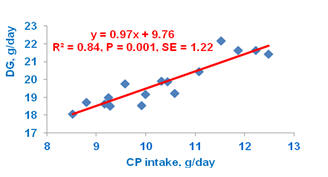 |
| Figure 2: Effect of CP intake on daily gain of rabbits in feeding experiment |
The economic analysis showed that the slightly higher total expense, but higher income were found in the seperate feeding and the CPU80-PG20 diet, resulting in giving more benefits in these diets. The results showed that the better separate feeding and the promising diets for the rabbits could be the CPU80-PG20 diet.
|
Table 4: Mean values for slaughter weights and carcass traits of growing rabbits |
||||||||
|
Feeding method (FM) |
Centrocema purbescens level (CL) |
SE/P |
|
|||||
|
Separate |
Mixed |
CPU20 |
CPU40 |
CPU60 |
CPU80 |
FM |
CL |
|
|
PG80 |
PG60 |
PG40 |
PG20 |
|||||
|
Live weight , g |
2040 |
1930 |
1840a |
1975ab |
2050b |
2075b |
28.7/0.02 |
40.6/0.01 |
|
Carcass W., g |
938 |
887 |
786a |
907b |
936b |
1022c |
12.0/0.008 |
17.0/0.001 |
|
Carcass ,% |
45.9 |
46.0 |
42.8a |
45.9b |
45.6b |
49.3c |
0.08/0.49 |
0.11/0.001 |
|
Thigh muscle W., g |
396 |
370 |
324a |
382b |
396b |
428c |
5.56/0.004 |
7.86/0.001 |
|
Lean meat W., g |
685 |
677 |
580a |
681b |
716bc |
748c |
10.9/0.61 |
15.5/0.001 |
|
Lean meat/CW ,% |
73.2 |
76.3 |
73.8a |
75.3b |
76.8c |
73.2a |
0.23/0.001 |
0.33/0.001 |
|
Means with different letters within the same rows are significantly different at the 5% level. W: weight, LW: live weight, CW: carcass weight |
||||||||
The live weight, carcass weight, thigh meat and percentage of lean meat and carcass weight were significantly affected (P<0.05) by feeding method and graded levels of Centrocema pubescens offered, the highest values were obtained for the animals fed separated feeds and the CPU80-PG20 diet (Table 4). The results in the present study were consistent with those in an earlier study of sweet potato vine replacing para grass in the diets reported by Nguyen Van Thu and Nguyen Thi Kim Dong (2005) that the percentage of carcass (without head) and lean meat of growing crossbred rabbits were from 41.6 to 47.1% and from 67.8 to 79.2%, respectively.
There were no significantly different interactions between two factors of feeding method and diet in feeding trial (P>0.05) for all of the criteria in Table 4.
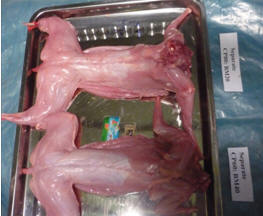 |
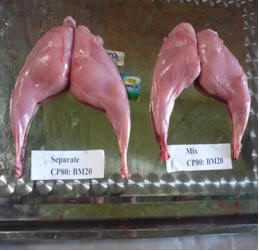 |
| Photo 3: Carcass weight of rabbits | Photo 4: Thigh weight of rabbits |
Experiment 2: Digestibility trial
Feed characteristics
Chemical compositions of feeds used in digestibility trial are shown in Table 5
|
Table 5: Chemical compositions of feed ingredients in digestibility trial (% DM) |
||||||
|
Ingredients |
DM |
OM |
CP |
NDF |
ADF |
ME (MJ/kg DM) |
|
Centrocema pubescens |
21.7 |
93.0 |
24.2 |
48.7 |
31.5 |
7.70 |
|
Para grass |
18.3 |
87.8 |
11.5 |
60.6 |
35.2 |
8.25 |
|
Soya waste |
11.2 |
95.1 |
20.8 |
33.9 |
30.0 |
11.3 |
|
Extracted soybean |
90.2 |
91.0 |
43.2 |
27.5 |
19.8 |
11.4 |
|
Dried sweet potato waste |
94.5 |
97.3 |
2.68 |
14.9 |
6.00 |
13.4 |
|
DM: dry matter, OM: organic matter, CP: crude protein, EE: ether extract, NDF: neutral detergent fibre, ADF: acid detergent fibre, ME: metabolizable energy (Maertens et al., 2002) |
||||||
Chemical compositions of feeds used (Table 5) was similar to those in Experiment 1.
Feed and nutrient intakes
Feed and nutrient intakes of rabbits in digestibility trial are indicated in Table 6.
|
Table 6. Feed and nutrient intakes (g/rabbit/ day) of rabbits in digestibility experiment |
||||||||
|
Item |
Feeding method (FM) |
Centrocema purbescens level (CL) |
SE/P |
|||||
|
Separate |
Mixed |
CPU20 |
CPU40 |
CPU60 |
CPU80 |
FM |
CL |
|
|
PG80 |
PG60 |
PG40 |
PG20 |
|||||
|
DM |
72.9 |
60.1 |
68.8a |
69.5a |
64.6b |
63.2b |
0.73/0.001 |
1.03/0.001 |
|
OM |
67.4 |
56.0 |
63.3a |
64.2ab |
12.3b |
11.7b |
0.66/0.001 |
0.94/0.005 |
|
CP |
12.1 |
10.1 |
10.5a |
11.2ab |
12.3b |
11.7b |
0.14/0.001 |
0.19/0.003 |
|
NDF |
28.8 |
21.4 |
27.4a |
27.2a |
23.7b |
22.2b |
0.40/0.001 |
0.56/0.001 |
|
ADF |
17.8 |
13.4 |
16.7a |
16.8a |
14.9b |
14.2b |
0.24/0.001 |
0.34/0.001 |
|
ME MJ/rabbit) |
0.75 |
0.63 |
0.71a |
0.72a |
0.67b |
0.66b |
0.01/0.001 |
0.02/0.001 |
|
Means with different letters within the same rows are significantly different at the 5% level. |
||||||||
Table 7: Apparent digestibility of dietary nutrients, nitrogen retention and caecum fluid parameters |
||||||||
|
Item |
Feeding method (FM) |
Centrocema purbescens level (CL) |
SE/P |
|
||||
|
Separate |
Mixed |
CPU20 |
CPU40 |
CPU60 |
CPU80 |
FM |
CL |
|
|
PG80 |
PG60 |
PG40 |
PG20 |
|||||
|
Digestibility, % |
||||||||
|
DM |
70.3 |
69.6 |
66.6a |
69.1ab |
71.4ab |
72.7b |
0.96/0.64 |
1.36/0.032 |
|
OM |
70.6 |
69.9 |
66.7a |
69.3a |
71.7ab |
72.9b |
0.96/0.55 |
1.36/0.028 |
|
CP |
77.7 |
78.9 |
73.0a |
78.0ab |
79.9b |
82.4b |
0.98/0.39 |
1.39/0.002 |
|
NDF |
55.4 |
48.4 |
49.7 |
50.6 |
54.2 |
53.3 |
1.54/0.006 |
2.18/0.46 |
|
ADF |
38.7 |
36.2 |
34.8 |
35.0 |
37.2 |
42.7 |
2.33/0.45 |
3.29/0.33 |
|
N balance (g/kg W 0,75) |
||||||||
|
N intake |
1.45 |
1.27 |
1.27a |
1.34a |
1.37ab |
1.47b |
0.02/0.001 |
0.03/0.001 |
|
N ret. |
0.86 |
0.83 |
0.71a |
0.83ab |
0.86ab |
0.99b |
0.03/0.41 |
0.04/0.002 |
|
Caecal fluid parameters |
||||||||
|
pH level |
6.96 |
6.95 |
6.96 |
6.94 |
6.99 |
6.94 |
0.04/0.83 |
0.06/0.93 |
|
N-NH3, mg/100ml |
14.7 |
14.5 |
14.2a |
14.4ab |
14.7b |
15.1c |
0.07/0.03 |
0.10/0.001 |
|
VFAs, mmol/l |
149 |
142 |
139a |
145ab |
147ab |
152b |
1.77/0.018 |
2.50/0.013 |
|
Means with different letters within the same rows are significantly different at the 5% level. N ret.: N retention, VFAs: volatile fatty acid |
||||||||
The apparent digestibility coefficients of DM, OM and CP and ADF were close between separate and mixed feeding (P>0.05), exception of higher CP digestibility for rabbits fed separated feeds (P<0.05). However, the values of DM, OM and CP were improved following graded CPU levels in the diets (P<0.05), as a results of decrease PG from 80 % to 20 % in the diets resulting in reducing NDF and ADF intakes (Table 7). Our results are in agreement with the findings that the lower digestibility indices of DM, CP and CF were found in diets including high fiber supplements (Khuc Thi Hue and Preston, 2006). The results of DM digestibility were similar to those (65.4 to 75.0 % and 69.0 %) in studies reported by Akinfala et al (2003) and Ramchurn et al (2000), respectively. The CP digestibility values in this trial are consistent with those of 80.6-83.1 % stated by Dang Hung Cuong (2008), but being slightly lower than the results of 79.5-87.0 % in a study of Tran Thanh Nhan (2011).
N intake was significantly higher for the rabbits fed separated feeds (P<0.05). There was a significant increase in both the nitrogen intake and nitrogen retention in the CPU80-PG20 diet (P<0.05). This probable explanation was a high CP content in CPU. The N retention in the present study is lower than the results obtained (1.22-1.77 g/kgW0,75 ) by Nguyen Le Thu Hang (2012). The concentration of N-NH3 and volatile fatty acids were significantly higher (P<0.05) for animals fed separated feeds and considerably increased with increasing levels of CPU from 20 to 80% in the diets (P<0.05). There was a close relationship between NDF digestibility and VFA concentration in the caecal fluid (Figure 3).
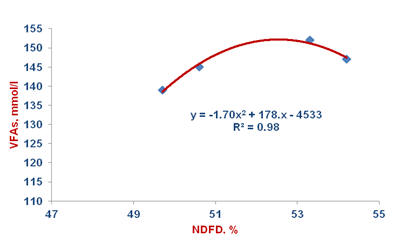 |
Figure 3: Relationship between NDF digestibility and VFA concentration in the caecal fluid |
There were no significantly different
interactions between two factors of feeding method and diet in digestibility
trial (P>0.05) for all criteria in Table 7.
Based on the results obtained it was concluded that:
· The separate feeding had higher intakes of feeds, nutrients, better growth performance and higher profit.
· A ratio of 80 % Centrocema pubescens and 20% Para grass in the diet gave the highest daily gain, better meat performance and profit.
· There were significant improvement of CP digestibility, N retention, the concentration of N-NH3 and volatile fatty acids in caecal fluid of rabbits
Acknowledgements
AOAC 1990 Official methods of analysis (15th edition). Washington, DC. Volume 1: 69-90
Barnett A J G. and Reid R L 1957 Studies on the production of volatile fatty acids from grass by rumen liquor in an artificial rumen. The volatile fatty acid production from grass. J. Agric. Sci. Cam. 48. pp, 315-321
Dang Hung Cuong 2008 Effect of Mucana pruriens replacing para grass (Brachiaria mutica) on feed and nutrient digestibility of growing crossbred rabbits. Graduate Thesis, Faculty of Agriculture and Applied Biology, Cantho University
Khuc Thi Hue and Preston T R 2006 Effect of different sources of supplementary fibre on growth of rabbits fed a basal diet of fresh water spinach (Ipomoea aquatica). Livestock Research for Rural Development. Volume 18, Article No. 58. http://www.cipav.org.co/lrrd/lrrd18/4/hue18058.htm
Leng R 2008 Digestion in the rabbit –a new look at the effects of their feeding and digestive strategies. International Workshop. Organic rabbit farming based on forages. 25-27 November 2008, Cantho University, Cantho City, Vietnam. http://www.mekarn.org/prorab/content.htm
Maertens L, J M Perez, M Villamide, C Cervera, T Gidenne and G.Xiccato 2002 Nutritive value of raw materials for rabbits: EGRAN tables 2002, World Rabbit Sci. 10, pp. 157-166
Mc Donald P, R A Edwards, J F D Greenhalgh and C A Morgan 1998 Digestibility evaluation of foods, In. Anim. Nutri., Fifth edition, pp. 220-237
Minitab 2000 Minitab reference manual release 13.20. Minitab Inc.
Nakkitset S 2007 Evaluation of head lettuce (Lactuca sativa) residues and Mimosa pigra as feed resources for growing rabbits. MSc Thesis. Swedish University of Agricultural Science, Uppsala 2007
Nguyen Le Thu Hang 2012 Effect of different crude protein levels on the growing performance and soft feces characteristics of different rabbit breeds. Graduate Thesis, Faculty of Agriculture and Applied Biology, Cantho University
Nguyen Thanh Tung 2012 Effect of different neutral detergent fiber levels on the growing performance, nutrient digestibility and soft feces characteristics of different rabbit breeds. BSc Thesis, Faculty of Agriculture and Applied Biology, Cantho University
Nguyen Truong Giang 2010 Effect of different levels supplementation of sweet potato vines and molasses on feed and nutrient digestibility and nitrogen retention of growing crossbred rabbits in the Mekong Delta. BSc thesis. Faculty of Agriculture and Applied Biology, Cantho University
Nguyen Van Dien 2007 Effect of Centrocema pubescens replacing para grass (Brachiaria mutica) on feed and nutrient digestibility of growing crossbred rabbits. Graduate Thesis, Faculty of Agriculture and Applied Biology, Cantho University
Nguyen Van Thu and Nguyen Thi Kim Dong 2005 Effect of replacement of different levels of para grass by sweet potato vines on feed utilization, growth rate and carcass quality of crossbred rabbits in the Mekong delta of Vietnam. In proceedings of Integrating Livestock-crop systems to meet the challenges of globalization. Ed. Rowlinson, P., Wachirapakorn, C., Pakdee, P., and Wanapat, M. Vol 2: T51
Preston T R 2008 Future trends of animal production adapted to the World food, feed and fuel crises. International Workshop. Organic rabbit farming based on forages. 25-27 November 2008, Cantho University, Cantho City, Vietnam. http://www.mekarn.org/prorab/content.htm
Ramchurn R, Dullull Z B, Ruggoo A and Roggoo J 2000 Effects of feeding star grass (Cynodon plectostachyus) on growth and digestibility of nutrients in the domestic rabbits. University of Mauritius, Reduit, Mauritius,http://www.cipav.org.co/lrrd.lrrd12/2/ram122.htm
Tran Thanh Nhan 2011 Effect of Mucana pruriens replacing para grass (Brachiaria mutica) and feeding methods on growth rate and nutrient digestibility of growing Crossbred rabbits. BSc Thesis, Faculty of Agriculture and Applied Biology, Cantho University
Van Phu Vinh 2010 Effect of different crude protein levels on feed and nutrient digestibility of growing Californian rabbits. BSc Thesis, Faculty of Agriculture and Applied Biology, Cantho University
Van Soest P J, J B Robertson and B A Lewis 1991 “Symposium: Carbohydrate methodology, metabolism and nutritional implications in dairy cattle: methods for dietary fiber, and nonstarch polysaccharides in relation to animal nutrition”, J. Dairy Sci. 74, pp. 3585-3597